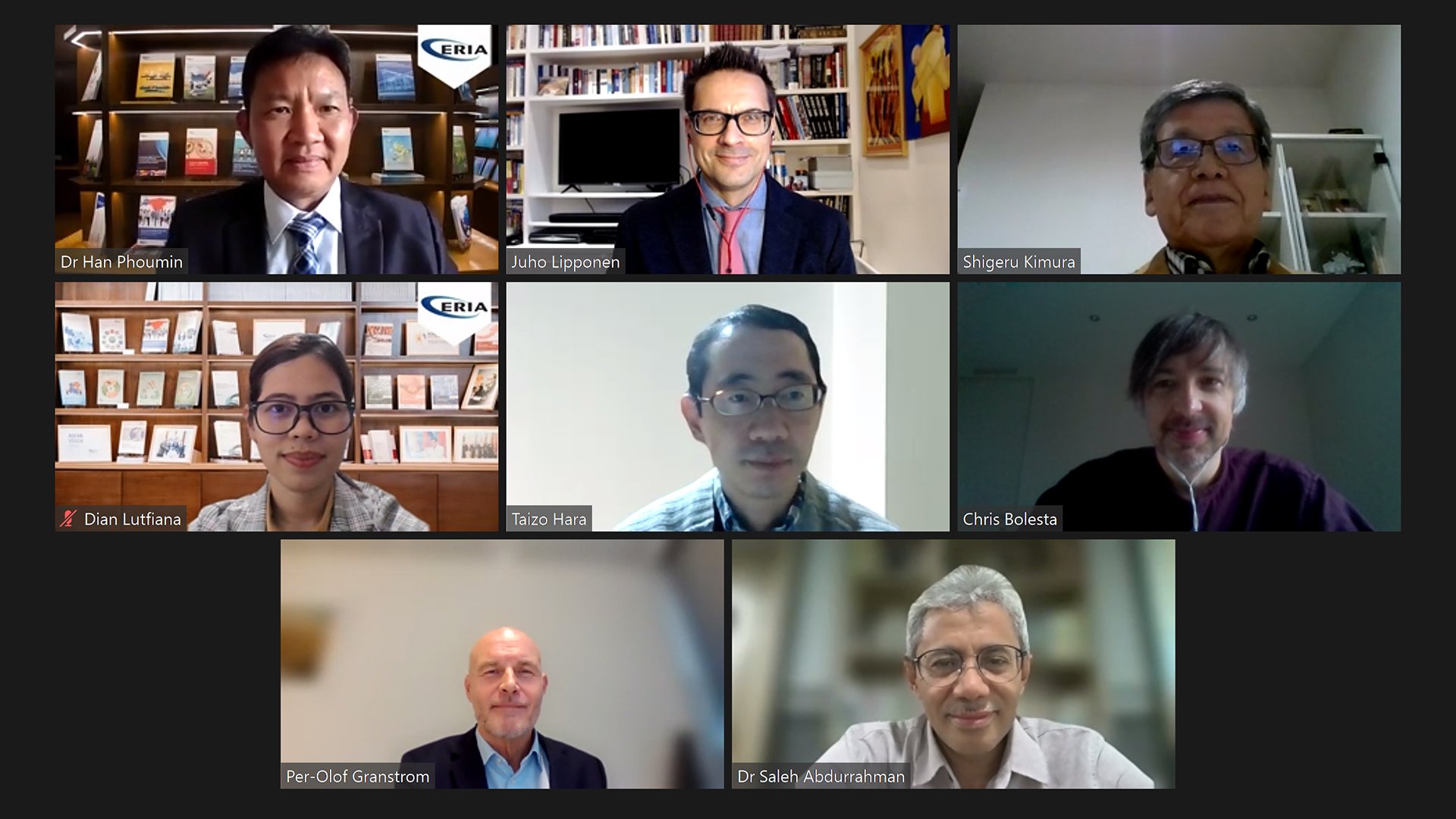European Stakeholders Offer Insights for a Successful CCUS Deployment in Asia
The 4th Knowledge Sharing Virtual Conference, 17 November 2021: Knowledge sharing and international cooperation between ASEAN and European countries will be central to achieving the collective target of net-zero emissions by 2050. Following the 26th Conference of the Parties to the United Nations Framework Convention on Climate Change (COP26), the road to carbon neutrality will further require the development and deployment of Carbon, Capture, Utilisation, and Storage (CCUS) technologies.
The Economic Research Institute for ASEAN and East Asia (ERIA) as the secretariat of Asia CCUS Network (ACN) brought together stakeholders from Europe and Southeast Asia for the 4th ACN Knowledge Sharing Conference. With the expected dependency of coal for power generation in Southeast Asia as well as being in the initial phase of developing CCUS technologies, ASEAN is turning to international partners in Europe to support its carbon-neutral objectives. ERIA, the European Commission and the Clean Energy Ministerial (CEM) CCUS Initiative co-hosted the conference on 17 November 2021.
Event moderator, Dr Han Phoumin, Senior Energy Economist, ERIA opened the conference with highlights on the significance of COP26 for CCUS development and deployment. Various international communities and country alliances are pressuring ASEAN to phase out coal by calling for an end to fossil fuel subsidies, determining carbon pricing, protecting vulnerable communities, and delivering promises on climate finance commitments. Dr Phoumin stated that ‘if all can be realised into policy action, it will have enormous impact on the speed or adoption of CCUS globally.’
Mr Taizo Hara, Director General of Research and Policy Design Administration of ERIA offered his Opening Remarks by noting the increasingly large consensus of moving away from fossil fuels and towards energy transition. For numerous developing countries, including ASEAN Member States (AMS), the transition will be challenging due to the high dependency on fossil fuels. Mr Hara called for policy changes towards renewable energy and the development of green energy, carbon offset mechanisms, and carbon sink technologies such as CCUS. Asia is required to learn from Europe’s longstanding experience in CCUS, as well as its successes and failures, to develop the region’s carbon sink technologies.
Mr Juho Lipponen, Coordinator CEM CCUS Initiative introduced the organisation’s member countries and main objectives to drive clean energy deployment. Mr Lipponen explained how CEM’s members are spread across North America, Europe, Africa, Asia Pacific, and the Middle East in which its stakeholders remain dedicated to accelerating CCUS development and deployment. He stressed the urgency of adopting CCUS, stating that ‘accelerating carbon capture is really important and vital now. We cannot think about this as something interesting in 2050.’ Mr Lipponen believes that although political support plays a significant role in becoming carbon neutral, knowledge sharing is equally important.
Mr Chris Bolesta, CCUS Policy Lead at European Union (EU) Commission led the first presentation on the topic of ‘Learning from Failures – Building on Success: EU Experience on CCUS’. In 2007, the EU set a goal of making Carbon, Capture, and Storage (CCS) commercially viable by 2020. The regional body started the process by rolling out initiatives covering aspects on regulatory framework, investment, knowledge sharing, infrastructure, and research initiatives. The EU established two funding mechanisms, setting aside as much as €180 million for one CCS project, because as Mr Bolesta stated, ‘We knew that at the time that it was at the stage that no one would invest in any projects.’
Although the EU’s initial plans seemed promising, several decarbonisation projects faltered. Mr Bolesta cited a collapse in Europe’s carbon pricing, difficulties in creating an integrated CCS value chain, and targeting coal in decarbonising the power sector as reasons behind the EU’s early failures. Learning from its mistakes, the EU refocused its strategy by determining a higher carbon price and opting for ‘smaller, more diversified, and not integrated projects.’ It has also forged ahead in exploring carbon dioxide (CO2) storage projects beyond pipelines and shipping in addition to providing certificates for carbon removals.
Mr Per-Olof Granström, EU Director, Zero-Emissions Platform (ZEP) shared his presentation on ‘ZEP’s View on EU Experience.’ Among the points mentioned, Mr Granström particularly highlighted the European Taxonomy for Sustainable Activities which he defines as, ‘the rulebook for investments in clean technology, which is a good basis for regulation for CCS in Europe, that lays out a clear basis of CCS being an economic activity that can make other activities sustainable.’ Currently, Europe is home to 40 market-ready CCUS projects poised to be operational before 2030 though much work remains. Mr Granström stated, ‘We have tough work on the Carbon, Capture, and Utilisation (CCU) development, and that all countries must have CCS and CCU in their strategies going forward.’
Several aspects can be improved in Europe including political recognition, capacity building on CCS and CCU, the inclusion of the two technologies in national energy, climate plans and industrial pathways as well as incentives for CO2 removals. Mr Granström underscored the significance of including non-governmental organisations (NGOs) onboard the EU’s carbon sink projects ‘to make it easier to drive this development forward.’
Dr Saleh Abdurrahman, Member of Committee for Downstream Oil and Gas Regulatory Body Former, Senior Advisor for Environment and Spatial Planning Ministry of Energy and Mineral Resources (MEMR), Indonesia spearheaded the Commentary Session where he agreed on the importance of CCS to reach net-zero targets by 2050 in Europe and 2060 in most ASEAN countries. He acknowledged that moving ahead, AMS will require further studies on CCUS implementation and CO2 transportation via shipping in addition to drafting regulations. Mobilising funding remains a top priority for the region ‘if we want these technologies to become an essential part for us to reach the goal of net-zero by 2050.’
During the Open Discussion session, event speakers and Dr Abdurrahman shared their insights on a range of questions posed by the audience. When prompted on whether CCUS will ensure affordability of electricity prices in Asia, Mr Bolesta explained that once CCS in power generation accelerates in the coming years, prices will stabilise. The second question was on attracting private capital for CCUS projects in the Asia Pacific in which Mr Granström answered that carbon pricing is crucial. Cooperation among the private and public sectors are equally vital as is cooperation on a regional- and country-level as well as between countries. Additionally, Mr Granström recommended the Asia Pacific enhance its CO2 infrastructure and forge relations with stakeholders of successful CCUS projects in Europe and globally.
Mr Bolesta answered the final question on the role of enhanced oil recovery (EOR) towards achieving greenhouse gas emissions in the EU. EOR projects in Europe is not commercially viable nor is it warmly accepted by European society. Mr Bolesta explained that ‘it could kill the whole CCS file because the green NGOs will say that it is not a climate mitigation technology, rather it is to get more fossil fuels. So, EOR discussion in Europe is very delicate.’ Dr Abdurrahman explained that there are three EOR projects in Indonesia expected to reduce CO2 emissions by 50 million tonnes starting in 2026 thus unlike Europe, Indonesia has a more open approach to the carbon-reducing mechanism.
During the discussion, Mr Lipponen suggested that the Asia Pacific region assess the reasons for the use of CCUS and have it orient the various policies and action plans required to realise the projects. On taxonomy, Mr Lipponen explained how clearly defining what constitutes sustainable activities can drive investments for CCUS projects, which Mr Granström also concurred. Mr Bolesta advised the Asia Pacific region to focus on one sector of the economy in the initial deployment of carbon sink technologies. He further recommended the region create simple mechanisms, avoid excessive legislation before the sector develops, and foster international cooperation. Dr Abdurrahman expressed hope that the EU and AMS enhance collaboration on CCUS deployment.
In his Closing Remarks, Mr Shigeru Kimura, Special Advisor to the President on Energy Affairs, ERIA, raised the need for strong political support and willingness in Asia to reinforce carbon neutral objectives. Mr Kimura explained that Asia uses coal mainly for power generation and its industry use is limited, pointing out the stark difference to Europe’s situation on coal. This demonstrates the relevance of creating a CCUS value chain for CO2 emissions derived from coal power plants for Asia to meet its net-zero targets. Mr Kimura ended his speech on a positive note, reassuring that the ACN will continue championing CCUS deployment, particularly in the Asia Pacific region through research studies and knowledge sharing.

